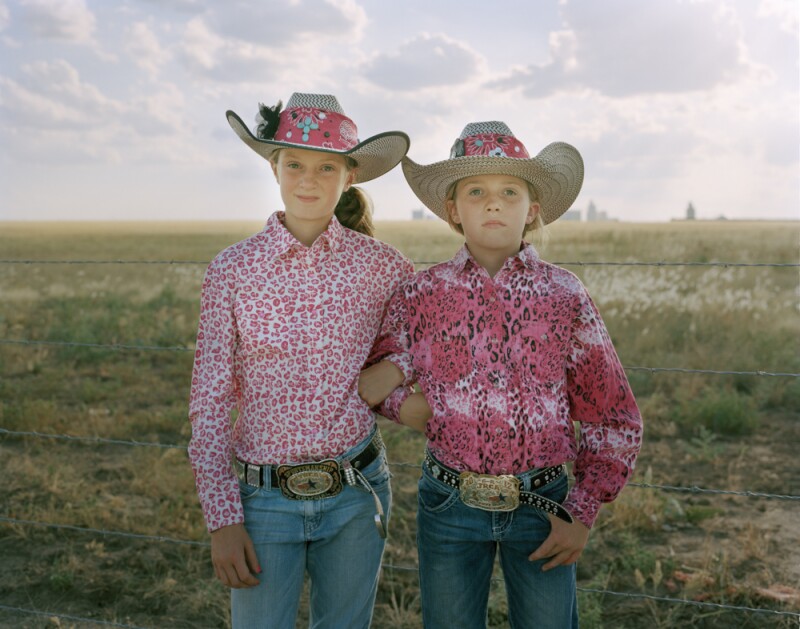A full-grown horse can weigh up to 1,210 pounds, depending on the breed. It can run as fast as 55 mph and the striking power of a hoof can be deadly. It’s no wonder then, that rodeos—still a bastion of the American Southwest tradition—conjure images of bucking broncos and big, grizzled cowboys swinging spurred boots around in a bowlegged saunter. It’s not an exclusively male sport—women have been celebrated competitors since its nascent days—but the world of rodeo is still seen as a masculine one. So imagine her surprise when Polish-American photographer Ilona Szwarc visited Texas and found that some of the most intriguing figures in rodeo are just little girls.
Szwarc would be quick to correct me here—there’s nothing “just little” about these young women. She refers to them as “individuals” and “young girls,” but never “little girls.”

Photo by Ilona Szwarc
Much of Szwarc’s work focuses on how girls and women live their lives and construct their identities. Fresh from a major project photographing American girls with their American Girl dolls, she traveled to Texas to visit friends. She had spent time as a high school exchange student in the state and had long been interested in creating a body of work that featured its landscape and culture. The bold, modern-day Annie Oakleys she met at a local rodeo offered her both an opportunity to work in Texas and the perfect complement to the American Girls project, almost a second chapter.

Photo by Ilona Szwarc
One of the things that drew Szwarc to the subject was the way these rodeo girls take up space in a male-dominated world. Unlike the girls in her American Girls series, the rodeo girls aren’t conventionally girly. They engage in traditionally male activities and pride themselves in their physical strength and power. But they still do value femininity—it’s just a nonconforming style of femininity. She tells me that many girls expressed a relief that they aren’t expected to behave in a girly way, that they are free to be whatever they want to be.

Photo by Ilona Szwarc
But it’s not just in the ring that these young women trade their dolls for horses. Competing in rodeos is a hobby and a way to carve out a community, yes; but for many, it’s also an identity.

Photo by Ilona Szwarc
There’s a practicality in the clothes these rodeo girls wear. Denim jeans protect their legs and heavy boots protect their toes. But Szwarc found it endearing that many girls find ways to co-opt the utilitarian fashion code and make it their own with feminine prints and accessories in their favorite colors. Often they’ll also accessorize their horses in a similar way, matching bridle colors or patterns with their own shirts and hats in a way that suggests the girl and the horse are a team.

Photo by Ilona Szwarc
Between the human and the horse, rodeo is a team sport—and a competitive one at that. A girl’s skills are important, but it’s also about having the best animal. Horses need to excel both in their performance and their appearance. The girls spend an extraordinary amount of time caring for their horses, from brushing them to conditioning their manes and giving them vitamin shots. Szwarc tells me that injuring a horse is one of the worst things that can happen in a competition. But she’s seen occasions when one girl’s horse would get injured and another girl would step in and offer her own as a substitute. Lending your horse to another competitor is a risky move, but the rodeo circuit is small and there’s a lot of kindness and generosity in the community.

Photo by Ilona Szwarc
There’s also a lot of toughness in this world, too. These girls may be tiny, but they’re strong enough to dominate animals multiple times their size. Some of these girls Szwarc worked with were as young as seven, but they still had enough muscular force to guide a horse in figure eights around a series of barrels or leap off a horse, catch a goat, and wrangle it into submission in the dust.

Photo by Ilona Szwarc
Not everyone is born into ranch life, but many of these young women have been riding for their entire lives—literally. Some were first placed in a saddle as soon as they were old enough to sit upright as babies. Szwarc met some mothers who would walk their children around on a horse for a little while every day so that they’d grow up used to the movements of a horse and learn to be confident around the massive animals.
But no matter how long they’d been living the rodeo life, Szwarc found these young women to be quietly empowered. She notes that, in a way, what they are doing is radical. Rodeo is a traditionally conservative institution, but while these young cowgirls pay homage to their cultural heritage, they are also clearly playing by their own rules.
See more of Szwarc’s work at ilonaszwarc.com.
>>Next: The Texas Riding Club Keeping Black Cowboy Culture Alive











